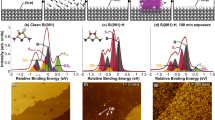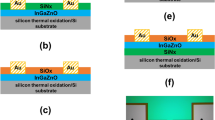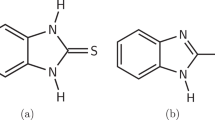Abstract
Passivation of semiconductor surfaces against chemical attack can be achieved by terminating the surface-dangling bonds with a monovalent atom such as hydrogen. Such passivation invariably leads to the removal of all surface states in the bandgap, and thus to the termination of non-metallic surfaces. Here we report the first observation of semiconductor surface metallization induced by atomic hydrogen. This result, established by using photo-electron and photo-absorption spectroscopies and scanning tunnelling techniques, is achieved on a Si-terminated cubic silicon carbide (SiC) surface. It results from competition between hydrogen termination of surface-dangling bonds and hydrogen-generated steric hindrance below the surface. Understanding the ingredient for hydrogen-stabilized metallization directly impacts the ability to eliminate electronic defects at semiconductor interfaces critical for microelectronics, provides a means to develop electrical contacts on high-bandgap chemically passive materials, particularly for interfacing with biological systems, and gives control of surfaces for lubrication, for example of nanomechanical devices.
This is a preview of subscription content, access via your institution
Access options
Subscribe to this journal
Receive 12 print issues and online access
$259.00 per year
only $21.58 per issue
Buy this article
- Purchase on Springer Link
- Instant access to full article PDF
Prices may be subject to local taxes which are calculated during checkout




Similar content being viewed by others
References
Oura, K., Lifshits, V.G., Saranin, A.A., Zotov, A.V. & Katayama, M. Hydrogen interaction with clean and modified silicon surfaces. Surf. Sci. Rep. 35, 1–69 (1999).
Higashi, G.S. & Chabal, Y.J. in Handbook of Silicon Wafer Cleaning Technology: Science, Technology, and Applications (ed. Kern, W.) 433–496 (Noyes, Park Ridge, New Jersey, 1993).
Boland, J.J. Structure of the H-saturated Si(100). Phys. Rev. Lett. 65, 3325–3328 (1990).
Derycke, V., Fonteneau, P., Pham, N.P. & Soukiassian, P. Molecular-hydrogen interaction with β-SiC(100)3×2 and c(4×2) surfaces and with Si atomic lines. Phys. Rev. B 63, 201305 (2001).
Higashi, G.S., Chabal, Y.J., Trucks, G.W. & Raghavachari, K. Ideal hydrogen termination of the Si(111) surface. Appl. Phys. Lett. 56, 656–658 (1990).
Schluter, M. & Cohen, M.L. Nature of conduction-band surface resonances for Si(111) surfaces with and without chemisorbed overlayers. Phys. Rev. B 17, 716–719 (1977).
Becker, R.S., Higashi, G.S., Chabal, Y.J. & Becker, A.J. Atomic scale conversion of clean Si(111):H-1×1 to Si(111)-2×1 by electron-stimulated desorption. Phys. Rev. Lett. 65, 1917–1920 (1990).
Pusel, A. & Wetterauer, U. & Hess, P. Photochemical hydrogen desorption from H-terminated Si(111) by VUV photons. Phys. Rev. Lett. 81, 645–648 (1998).
Vondrak, T. & Zhu, X.Y., Direct photodesorption of atomic hydrogen from Si(100) at 157 nm: experiment and simulation. J. Phys. Chem. B 103, 4892–4899 (1999).
Fowler, A.B. IBM Corporation, Armonk, New York. Process for the elimination of interface states in MIOS structures. US patent 3,849,204 (1974).
Lyding, J.W., Hess, K. & Kizilyalli, I.C. Reduction of hot electron degradation in metal oxide semiconductor transistors by deuterium processing. Appl. Phys. Lett. 68, 2526–2528 (1996).
Becker, R.S., Becker, A.J., Higashi, G.S. & Chabal, Y.J. Surface chemical reactions studied with scanning tunnelling microscopy. Scan. Microsc. 7 (suppl.), 269–280 (1993).
Foley, E.T., Kam, A.F., Lyding, J.W. & Avouris, P. Cryogenic UHV-STM study of hydrogen and deuterium desorption from Si(100). Phys. Rev. Lett. 80, 1336–1339 (1998).
Shen, T.-C. et al. Atomic-scale desorption through electronic and vibrational excitation mechanisms. Science 268, 1590–1592 (1995).
Watanabe, S., Ono, Y.A., Hashizume, T., Wada, Y., Yamauchi, J. & Tsukada, M. Electronic structure of an atomic wire on a hydrogen-terminated Si(111) surface: first-principles study. Phys. Rev. B 52, 10768–10771 (1995).
Doumergue, P., Pizzagalli, L., Joachim, C., Altibelli, A. & Baratoff, A. Conductance of a finite missing hydrogen atomic line on Si(001)–(2×1)–H. Phys. Rev. B 59, 15910–15916 (1999).
Bowler, D.R. & Fisher, A.J. Small polaron formation in dangling-bond wires on the Si(001) surface. Phys. Rev. B 63, 035310/1–4 (2001).
Maier, F., Riedel, M., Mantel, B., Ristein, J. & Ley, L. Origin of surface conductivity in diamond. Phys. Rev. Lett. 85, 3472–3475 (2000).
Bermudez, V.M. Structure and properties of cubic silicon carbide (100) surfaces: a review. Phys. Status Solidi B 202, 447–473 (1997).
Soukiassian, P. Cubic silicon carbide surface reconstructions and Si (C) nanostructures at the atomic scale. Mater. Sci. Eng. B 96, 115–131 (2002).
D'angelo, M. et al. in Proc. Eur. Conf. Silicon Carbide Related Mat. 2002 — ECSCRM' 2002 (eds Bergman, P. & Janzén, E.) (Materials Science Forum, in the press).
Semond, F., Soukiassian, P., Mayne, A.J., Dujardin, G., Douillard, L. & Jaussaud, C. Atomic structure of the β-SiC(100) 3×2 surface. Phys. Rev. Lett. 77, 2013–2016 (1997).
Lu, W., Kruger, P. & Pollmann, J. Atomic and electronic structure of β-SiC(001) 3×2. Phys. Rev. B 60, 2495–2504 (1998).
Soukiassian, P. et al. Direct observation of a β-SiC(100) c(4×2) surface reconstruction. Phys. Rev. Lett. 78, 907–910 (1997).
Catellani, A., Galli, G., Gygi, F & Pellacini, F. Influence of stress and defects on the silicon-terminated SiC(001) surface structure. Phys. Rev. B 57, 12255–12261 (1998).
Aristov, V.Yu., Douillard, L., Fauchoux, O. & Soukiassian, P. Temperature-induced semiconducting c(4×2) ⇔ metallic 2×1 reversible phase transition on the β-SiC(100) surface. Phys. Rev. Lett. 79, 3700–3703 (1997).
Yeom, H.W. et al. Electronic structure of the Si-rich 3C–SiC(001) 3×2 surface. Phys. Rev. B 58, 10540–10550 (1998).
Reutt, J.E., Chabal, Y.J. & Christman, S.B. Coupling of H vibration to substrate electronic states in Mo(100)-p(1×1)H and W(100)-p(1×1)H: example of strong breakdown of adiabaticity. Phys. Rev. B 38, 3112–3132 (1988).
Chabal, Y.J. & Raghavachari, K. Surface infrared study of Si(100)-(2×1)-H. Phys. Rev. Lett. 53, 282–285 (1984).
Chabal, Y.J. Infrared spectroscopy of hydrogen on silicon surfaces. Physica B 170, 447–456 (1991).
Chabal, Y.J. & Raghavachari, K. New ordered structure for the H-saturated Si(100) surface: the (3×1) phase. Phys. Rev. Lett. 54, 1055–1058 (1985).
Chabal, Y.J., Higashi, G.S., Raghavachari, K. & Burrows, V.A. Infrared spectroscopy of Si(111) and Si(100) surfaces after HF treatment: H termination and surface morphology. J. Vac. Sci. Technol. A 7, 2104–2109 (1989).
Sieber, N., Stark, T., Seyller, Th., Ley, L., Zorman, C.A. & Mehregany, M. Origin of the split Si–H stretch mode on hydrogen terminated 6H-SiC (0001): titration of crystal truncation. Appl. Phys. Lett. 80, 4726–4729 (2002).
Raghavachari, K., Jakob, P. & Chabal, Y.J. Step relaxation and surface stress at H-terminated vicinal Si(111). Chem. Phys. Lett. 206, 156–160 (1993).
Soukiassian, P., Semond, F., Mayne, A. & Dujardin, G. Highly stable Si atomic line formation on the β-SiC(100) surface. Phys. Rev. Lett. 79, 2498–2501 (1997).
Soukiassian, P. & Dujardin, G. Des lignes d'atomes au diamant. La Recherche 321, 38–41 (1999).
Soukiassian, P. in Physics, Chemistry and Application of Nanostructures (eds Borisenko, V. E., Gaponenko, S. V. & Gurin, V. S.) 340–353 (World Scientific, 2001).
Bechstedt, F. et al. Towards quantum structures in SiC. Mater. Sci. Forum 389–393, 737–742 (2002).
Salmeron, M. Generation of defects in model lubricant monolayers and their contribution to energy dissipation in friction. Tribol. Lett. 10, 69–79 (2001).
Acknowledgements
The authors are grateful to W.L. Brown for his leadership of the IRAS work done at Agere Systems and many discussions, to V. Yu. Aristov, N.P. Pham, N. Rodriguez and S. Saada for their support of the STM/STS and photo-emission work done at CEA-Saclay and Elettra (Trieste), to G. Galli and S. Laetitia for discussions, to C. Ottaviani and M. Pedio for assistance in the synchrotron radiation experiments done at Elettra (Trieste), to T. Billon, L. di Cioccio and C. Pudda (CEA-LETI), and A. Lescuras (CNRS-CHREA) for providing single-domain β-SiC(100) samples.
Author information
Authors and Affiliations
Corresponding author
Ethics declarations
Competing interests
The authors declare no competing financial interests.
Supplementary information
Movie showing the different steps of the interaction of hydrogen atoms with the β-SiC(100) 3x2 surface
1) Hydrogen atoms decorating the Si dangling bonds of the topmost surface (GIF 291 kb)
Subsequently, Si-Si dimers in the first plan becoming symmetric
2)The hydrogen atoms then breaks the Si-Si dimers in the 3rd atomic layer below the surface (located just above the 1st carbon plane) resulting in the formation of 2 dangling bonds
3) H atom decorating one of these dangling bond but, due to steric conditions and lack of space, unable to decorate the second one
4) This results in a charge transfer into the underlying plane leading to Metallisation.
Rights and permissions
About this article
Cite this article
Derycke, V., Soukiassian, P., Amy, F. et al. Nanochemistry at the atomic scale revealed in hydrogen-induced semiconductor surface metallization. Nature Mater 2, 253–258 (2003). https://doi.org/10.1038/nmat835
Received:
Accepted:
Published:
Issue Date:
DOI: https://doi.org/10.1038/nmat835
This article is cited by
-
Fermi level pinning characterisation on ammonium fluoride-treated surfaces of silicon by energy-filtered doping contrast in the scanning electron microscope
Scientific Reports (2016)
-
Hydrogen-induced nanotunnel opening within semiconductor subsurface
Nature Communications (2013)
-
Doping of SiGe core-shell nanowires
Journal of Computational Electronics (2012)
-
Control of electronic conduction at an oxide heterointerface using surface polar adsorbates
Nature Communications (2011)
-
Engineering Cubic Silicon Carbide Surfaces Properties Using Hydrogen: Metallization versus Passivation
Applied Physics A (2006)



